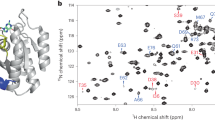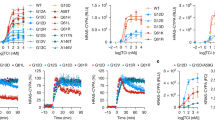Abstract
The ras proto–oncogene1, found in all eukaryotes so far examined2–9, encodes a protein with guanine nucleotide-binding and GTPase activity10–13. Gene disruption experiments in yeast indicate that ras is essential for cell growth14. Anti-sense mutagenesis approaches suggest that this is also true for Dictyostelium15. Most mutations causing an amino-acid substitution for Gly 12 result in decreased GTPase activity and produce a transforming phenotype16–19. In yeast, a Gly 19 → Val 19 missense mutation (Gly 19 is similar to Gly 12 in mammalian and Dictyostelium ras proteins) causes a series of dominant phenotypes, including elevated adenylate cyclase activity20. In mammalian cells there is no evidence that ras activates adenylate cyclase activity21. D. discoideum contains a single ras gene (Dd-ras) that encodes a protein very similar to the mammalian ras protein4 and identical to c-ras at the potentially transforming positions. Dd-ras is expressed in vegetative cells and later in development in prestalk cells whereas ras protein is found in vegetative and developing cells. In the migrating pseudoplasmodium, ras protein is found in prestalk but not prespore cells, suggesting it is involved in the function and/or differentiation of the anteriorly localized prestalk cells. In this report we examine the effects of expression of a Dd-ras gene carrying a Gly 12 → Thr 12 missense mutation.
This is a preview of subscription content, access via your institution
Access options
Subscribe to this journal
Receive 51 print issues and online access
$199.00 per year
only $3.90 per issue
Buy this article
- Purchase on SpringerLink
- Instant access to full article PDF
Prices may be subject to local taxes which are calculated during checkout
Similar content being viewed by others
References
Taparowsky, E. et al. Nature 300, 762–765 (1982).
Powers, S. et al. Cell 36, 607–612 (1984).
Dhar, R., Nieto, A., Koller, R., DeFeo-Jones, D. & Scolnick, E. M. Nucleic Acids Res. 12, 3611–3629 (1984).
Reymond, C. D., Gomer, R. H., Mehdy, M. C. & Firtel, R. A. Cell 39, 141–148 (1984).
Neuman-Silberberg, F. S., Schejter, E., Hoffman, F. M. & Shilo, B.-Z. Cell 37, 1027–1033 (1984).
Capon, D. J., Chen, E. Y., Levinson, A. D., Seeburg, P. H. & Goeddel, D. V. Nature 302, 33–37 (1983).
Reddy, E. P. Science 223, 1061–1063 (1983).
McGrath, J. P. et al. Nature 304, 501–506 (1983).
Taparowsky, E., Shimizu, K., Goldfarb, M. & Wigler, M. Cell 34, 581–586 (1983).
Hurley, J. B., Simon, M. I., Teplow, D. B., Robishaw, J. D. & Gilman, A. G. Science 226, 860–862 (1984).
Tanabe, T. et al. Nature 315, 242–245 (1985).
Manne, V., Yamazuki, S. & Kung, H.-F. Proc. natn. Acad. Sci. U.S.A. 81, 6953–6957 (1984).
Manne, V., Bekesi, E. & Kung, H.-F. Proc. natn. Acad. Sci. U.S.A. 82, 376–380 (1985).
Kataoka, T. et al. Cell 37, 437–445 (1984).
Reymond, C. D., Nellen, W. & Firtel, R. A. Proc. natn. Acad. Sci. U.S.A. 82, 7005–7009 (1985).
Fasano, O. et al. Proc. natn. Acad. Sci. U.S.A. 81, 4008–4012 (1984).
Seeburg, P. H., Colby, W. W., Capon, D. J., Goeddel, D. V. & Levinson, A. D. Nature 312, 71–75 (1984).
Shimizu, K. et al. Nature 304 497–500 (1983).
Balmain, A. & Pragnett, I. B. Nature 303, 72–74 (1983).
Toda, T. et al. Cell 40, 27–36 (1985).
Beckner, S. K., Hattori, S. & Shih, T. Y. Nature 317, 71–72 (1985).
Sussman, M. Meth. Cell Physiol. 2, 397–410 (1966).
Nellen, W., Silan, C. & Firtel, R. A. Molec. cell. Biol. 4, 2890–2898 (1984).
Nellen, W. & Firtel, R. A. Gene 5, 155–163 (1985).
Devreotes, P. N. in The Development of Dictyostelium discoideum (ed. Loomis, W. F.) 117–168 (Academic, New York, 1982).
Sussman, M. in The Development of Dictyostelium discoideum (ed. Loomis, W. F.) 353–385 (Academic, New York, 1982).
Schaap, P., Konijn, T. M. & Van Haastert, P. J. M. Proc. natn. Acad. Sci. U.S.A. 81, 2122–2126 (1984).
Schaap, P. & Spek, W. Differentaition 27, 83–87 (1984).
Schaap, P. & Wang, M. Devl Biol. 105, 470–478 (1984).
Nestle, M. & Sussman, M. Devl Biol. 28, 545–554 (1972).
Van Haastert, P. J. M. Biochem. biophys. Res. Commun. 124, 597–604 (1984).
Europe-Finner, G. N. & Newell, P. C. FEBS Lett. 171, 315–319 (1984).
Berlot, C. H., Spudich, J. A. & Devreotes, P. N. Cell 43, 307–314 (1985).
Theibert, A. & Devreotes, P. J. biol. Chem. (submitted).
Zoller, M. J. & Smith, M. Nucleic Acids Res. 10, 6487–6500 (1982).
Maniatis, T., Fritsch, C. F. & Sambrook, J. Molecular Cloning, a Laboratory Manual (Cold Spring Harbor Laboratory, New York, 1982).
Sanger, F., Nicklen, S. & Coulson, A. Proc. natn. Acad. Sci. U.S.A. 74, 5463–5476 (1977).
Springer, W. R., Cooper, D. N. W. & Barondes, S. H. Cell 39, 557–564 (1984).
Mehdy, M. C., Ratner, D. & Firtel, R. A. Cell 32, 761–771 (1983).
Author information
Authors and Affiliations
Rights and permissions
About this article
Cite this article
Reymond, C., Gomer, R., Nellen, W. et al. Phenotypic changes induced by a mutated ras gene during the development of Dictyostelium transformants. Nature 323, 340–343 (1986). https://doi.org/10.1038/323340a0
Received:
Accepted:
Issue date:
DOI: https://doi.org/10.1038/323340a0
This article is cited by
-
PSF and CMF, autocrine factors that regulate gene expression during growth and early development ofDictyostelium
Experientia (1995)
-
Phylogenesis of fission yeasts. Contradictions surrounding the origin of a century old genus
Antonie van Leeuwenhoek (1995)
-
Transmembrane signalling in eukaryotes: a comparison between higher and lower eukaryotes
Plant Molecular Biology (1994)
-
Investigation of the mechanism underlying the inhibitory effect of heterologous ras genes in plant cells
Plant Molecular Biology (1993)
-
Yeast RAS2 affects cell viability, mitotic division and transient gene expression in Nicotiana species
Plant Molecular Biology (1990)



